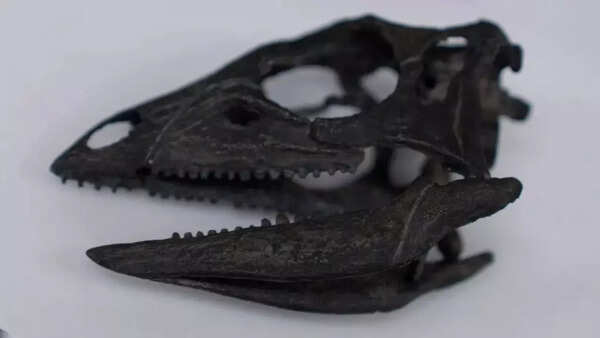Scientists have announced the discovery of a new, diminutive dinosaur species. This dog-sized dinosaur roamed the Earth alongside some of the largest creatures ever to exist, offering valuable insights into the biodiversity of prehistoric ecosystems.

According to a report in The BBC, the new species, named Enigmacursor mollyborthwickae, is detailed in a study published in Royal Society Open Science. The dinosaur, about the size of a Labrador retriever with half its length attributed to its tail, was initially misclassified as a Nanosaurus. The specimen is currently showcased at the Natural History Museum (NHM).
Enigmacursor, meaning “puzzling runner,” stood approximately 64 cm tall and 180 cm long. This small, agile dinosaur is distinguished by its relatively large feet and elongated tail. It coexisted with dinosaurs such as the Stegosaurus approximately 150 million years ago.

The reclassification occurred after scientists questioned the initial identification and traveled to the US to examine the original Nanosaurus fossil. The investigation revealed the original specimen was incomplete. It consisted of a rock containing only bone impressions, making definitive identification impossible.

Despite its small size, Enigmacursor thrived in its environment, scurrying around the feet of massive herbivorous and carnivorous dinosaurs. This discovery provides crucial information on how smaller species adapted and survived alongside colossal contemporaries, illustrating the complexity of prehistoric life.

This find significantly expands our understanding of dinosaur diversity, evolution, and behavior. It challenges the assumption that large dinosaurs exclusively dominated ecosystems and demonstrates that smaller species played vital roles. This discovery also provides valuable data for studying long-term evolutionary relationships.
Newer articles
Older articles
 Moto G54 Gets Significant Price Cut in India, Making Budget Smartphone Even More Appealing
Moto G54 Gets Significant Price Cut in India, Making Budget Smartphone Even More Appealing
 Africa's Rift Valley: Mantle Upwelling Drives Continent's Split and Birth of New Ocean
Africa's Rift Valley: Mantle Upwelling Drives Continent's Split and Birth of New Ocean
 X Cracks Down: Over Half a Million Indian Accounts Suspended for Policy Breaches
X Cracks Down: Over Half a Million Indian Accounts Suspended for Policy Breaches
 Vijay Sethupathi Apologizes Amid Controversy Over Son Surya's Debut Film 'Phoenix'
Vijay Sethupathi Apologizes Amid Controversy Over Son Surya's Debut Film 'Phoenix'
 Jadeja's Accuracy Questioned: Ex-India Pacer Slams Spin Strategy in England Test Loss
Jadeja's Accuracy Questioned: Ex-India Pacer Slams Spin Strategy in England Test Loss
 IRCTC's AI Chatbot Revolutionizes Train Ticket Booking, Refunds, and Information Access
IRCTC's AI Chatbot Revolutionizes Train Ticket Booking, Refunds, and Information Access
 Ashada Gupt Navratri 2025: Unveiling Dates, Sacred Rituals & Hidden Significance of the Monsoon Festival
Ashada Gupt Navratri 2025: Unveiling Dates, Sacred Rituals & Hidden Significance of the Monsoon Festival
 Google Maps Enhances Directional Accuracy with Fused Orientation Provider Update
Google Maps Enhances Directional Accuracy with Fused Orientation Provider Update
 xAI to Open Source Grok, Democratizing Access to Musk's AI Chatbot
xAI to Open Source Grok, Democratizing Access to Musk's AI Chatbot
 Android Users Urged to Patch Now: Critical Security Flaws Expose Devices to Attacks
Android Users Urged to Patch Now: Critical Security Flaws Expose Devices to Attacks